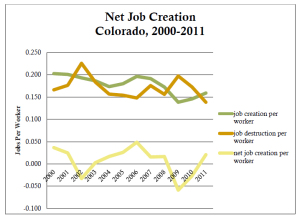Colorado is a place where entrepreneurs are creating businesses at a higher rate than other states, although many of those small companies struggle to survive their first five years. But that’s not as bad as it sounds, according to a new report from Colorado State University.
“Small businesses are major job engines, and while young companies create and destroy more jobs than average, over the long term, a highly dynamic economy like Colorado’s helps illuminate promising market opportunities,” said Stephan Weiler, professor of economics at CSU and the author of the Colorado Innovation Report 2014. “Such dynamism creates healthier companies and results in higher job growth in the long run.”

Weiler used the analogy of a seedbed: “If you plant more seeds, you’ll have more duds but also more chances to grow a Google.”
One factor in the failure of young companies has been the financing gap — the so-called “Valley of Death” — at that critical stage of development where the availability of funding literally means life or death.
Small business bank lending in Colorado is above the national average, Weiler found, and consistently ranks in the top third for access to capital among its peer states. That gives the state’s entrepreneurs an advantage during the early stages of their business, since most startups still get their financing from sources other than banks.
Filling the skills gap
The coming “skills gap” in Colorado also offers opportunities for new kinds of workers.
“As white male Boomers retire, they create openings that can be filled not only by women, but Hispanics and Latinos who make up a significant portion of Colorado’s population — and are also attending colleges such as Colorado State in increasing numbers.
“The skilled workforce that has been largely male is transitioning to become significantly more female, as male education attainment drops relative to that of women,” Weiler explained. “Educated men are disproportionately older and retiring, while educated women are disproportionately younger.
“While we are continuing to benefit from the in-migration of young people to Colorado, employers have the additional opportunity to replace retiring workers with homegrown talent,” Weiler added.
Focus on innovation and entrepreneurship
Taken together, these factors point toward Colorado’s economy recovering from the Great Recession at a faster rate than other states thanks to its focus on innovation and entrepreneurship.
“Skilled workers and access to capital combined with the industriousness of entrepreneurs can solidify Colorado’s economic dynamism, creating the potential for long-term growth for years to come,” Weiler said.
This is the third year Weiler has researched the state of innovation in Colorado, the first that the report has been published by CSU. The current report, as well as those released in 2012 and 2013, can be found at innovation.colostate.edu.